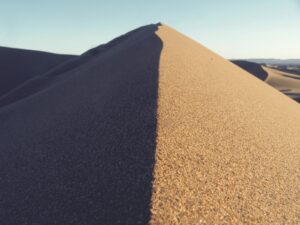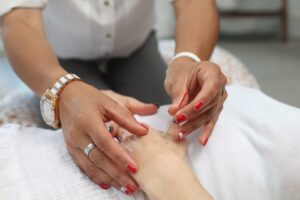Subscribe to the Newsletter
If you are interested in understanding how Traditional Chinese Medicine can improve your life sign up to my newsletter for the latest updates.

Luo-connecting points, sometimes also known as ‘junction‘ points, lie on acupuncture channels, one per channel.
Each of these points is where a separate, secondary channel rises from the primary acupuncture channel. Where it goes shows you at least one important way the point can be used.
These luo-connecting points have other functions, both superficial and deep, well worth knowing about if you’re an acupuncturist.
If you’re not an acupuncturist or student of acupuncture, this page probably won’t be useful. However, some of my patients think that knowing more about all this helps them understand their condition more easily. So here it is.
To make more sense of this, best to read first the page on luo-connecting channels.
Some luo-connecting points, like Lung point 7, Lieque, have little flesh under them so deep needling is not possible, although one can needle shallowly – ie transversely – along under the skin a good distance, of course.
Others, like Stomach 40, below, are in quite muscular locations.

Usually, if the problem is of recent origin or acute, shallow needling, indeed VERY shallow needling, is better.
Deeper needling may apply to the treatment of conditions where the luo-connecting channel extends to organs (zang-fu) or locations in the trunk or on the head.
All of them are discrete points on the primary channels. However, in the original sense, luo points might lie anywhere along a channel where there was, for example, swelling or ‘excess’.
The specific points we now use as luo-connecting points seem to have considerable influence on swellings or strains along their channels, so can be added to assist treatment at ‘ahsi’ – painful – points.
But they have great influence on how qi functions, in many ways.
When reading the following, bear in mind that each of the luo-connecting points has a whole range of other properties, which you can read about by clicking the link to the point.What follows on this page are the pathway and symptoms connected with their being luo-connecting points. You could say that each luo-connecting channel has a kind of central control HQ: its luo-connecting point.
The Spleen luo pathway joins up with its partner primary channel, that of the Stomach. It then extends from Spleen 4 up to the abdomen, connecting with the intestines and the stomach. This contributes to why this point is so effective for treating abdominal pain and discomfort. This may also be partly why this point is the Master point for the Chong Mo Extraordinary vessel.
Symptoms of Fullness: sticking or lancinating pain in the intestines; abdominal pain
Symptoms of Qi stagnation from Qi deficiency: drum-like distension of the abdomen
Emptiness: distension of the abdomen
Symptoms of counterflow qi: symptoms like those of cholera or food-poisoning
Symptoms of Blood stasis in this channel: abdominal pain and blood in the stools
Cold: dislike of cold, fever; heaviness in the abdomen, diarrhoea
For more, see Spleen 4.

The Heart luo pathway extends from Tongli, Heart 5, to join up with its partner channel, that of the Small Intestine. It then proceeds up the Heart primary acupuncture channel to the heart, and from there continues to the tongue and the eyes.
Symptoms of Fullness: sense of fullness and pressure in the chest and diaphragm
Symptoms of Emptiness: loss of speech – unable to speak
The Bladder luo pathway starts at Bladder 58, Feiyang. It then joins up with its partner channel, that of the Kidney.
Symptoms of Fullness: nose feels congested, with a clear discharge, headache, back pain: these are all possible acute symptoms of invasion of Wind-Cold
Symptoms of Emptiness: clear nasal discharge, with epistaxis
The Kidney luo pathway starts at Kidney 4, Dazhong. It then circles round the heel and joins up with its partner channel, that of the Bladder. It extends up the Kidney channel to the Pericardium, then flows downwards to spread out over the lumbar vertebrae.
Symptoms of Fullness: constipation and urinary retention
Symptoms of Emptiness: low backache
Counterflow qi: depressed, irritable; sense of heaviness on the chest
The Three-Heater luo pathway starts at Three Heater 5, then extends up the posterior surface of the arm to the shoulder. From there it travels to the centre of the chest to connect with the Pericardium.
Symptoms of Fullness: elbow spasms
Symptoms of Emptiness: weak, flaccid muscles in the arm
The Gallbladder luo pathway starts at Gallbladder 37, then joins up with its partner channel, that of the Liver. It then travels downwards and spreads out in the dorsum of the foot.
Symptoms of Fullness: fainting. There would almost certainly be other symptoms too! Fainting may due to a number of syndromes in Chinese medicine.
Symptoms of Emptiness: weakness and loss of tone in the lower limbs and feet, and great difficulty standing up from a sitting position
The Liver luo pathway begins at Liver 5, Ligou, then joins up with its partner channel, that of the Gallbladder. It then extends up to the genitals.
Symptoms of Fullness: swollen testes; hernia in the groin
Symptoms of Emptiness: intensive genital/pubic itching
Counterflow qi: abnormal erections, eg priapism
Damp: dislike of cold, fever; hypogastric heaviness; urge to urinate, with burning pain during urination.
For more, see Liver 5.
The Conception Vessel luo pathway starts at Conception Vessel 15, from where it spreads out over the abdomen.
Symptoms of Fullness: pain in the skin of the abdomen
Symptoms of Emptiness: itching skin of the abdomen
The Governing Vessel luo pathway begins at Governor 1, Changqiang. It then flows up on either side of the spine to the neck. From there it spreads over the occiput and disperses at the vertex.In the upper back, it connects with the Bladder channel. From here it enters the spine.
Symptoms of Fullness: rigid or stiff back, held so erect that it may lean backwards
Symptoms of Emptiness: heaviness of the head, and/or shaking of the head, unable to hold it still
The Great Spleen luo pathway starts at Spleen 21, Dabao and from there disperses in the chest and hypochondrium.
Symptoms of Fullness: aches and pains all over the body and limbs, often with stiffness
Symptoms of Emptiness: looseness of the joints, weakness of the muscles of the limbs
The Great luo-connecting channel of the Stomach is said to start in the chest, go through the diaphragm, connect to the lungs and exit or disperse under the left breast. Symptoms in these areas seem to benefit from treatment at Stomach 40.
Bear in mind that the Lung channel commences in the region of the stomach: the Lungs and the Stomach have a very close relationship, to my mind, at least.
1. One way of using these luo-connecting points is in transferring energy from one side of the body to the other.
Tonifying a luo-connecting point on one side of the body and dispersing it on the other can sometimes help to balance the flow of Qi along the channels, by strengthening it on the first side and easing it out on the second.
At least, so it seems to me when it works: it doesn’t always! Also, sometimes it works even if just one side is so treated.
2. These Luo-Connecting channels are quite different to the Divergent channels. Although there is some connection between them I’ve never found it relevant in treating people.
3. Because the luo-connecting channels work at different depths, in treating them with acupuncture it is important to needle to the correct depth and in the correct way. This is quite a big subject, and applies as much to points lying along the primary channel as to the luo-connecting points themselves.
4. Acupuncturists need to be careful not to needle luo-connecting points too deeply when the invading Qi is still at a superficial level. Why? Because, at least in theory, and to a certain extent in my experience, needling one of these luo-connecting points too deeply can push the invader deeper faster – or to put it perhaps a better way, it allows the invader access to deeper levels more easily – when the right treatment might have pushed it out completely.

Stay in Touch!
No spam, only notifications about new articles and updates.

Book a Video consultation if you want to know more about your symptoms

This Introductory Chinese medicine course introduces you to the amazing thinking behind this ancient medicine, now increasingly in demand.

The Scottish College for Chinese medicine provides introductory courses for all, explaining Chinese medicine and its cultural background.

Master Tung’s acupuncture is a hidden treasure, lost to China but recovered in Taiwan from where it spread round the world.

Knee pain has five main causes. It’s certainly worth trying acupuncture before you resort to surgery!
Subscribe to the Newsletter
If you are interested in understanding how Traditional Chinese Medicine can improve your life sign up to my newsletter for the latest updates.
Subscribe to the Newsletter
If you are interested in understanding how Traditional Chinese Medicine can improve your life sign up to my newsletter for the latest updates.